[English] 日本語
 Yorodumi
Yorodumi- PDB-7eo4: Cryo-EM of Sphingosine 1-phosphate receptor 1 / Gi complex bound ... -
+ Open data
Open data
- Basic information
Basic information
| Entry | Database: PDB / ID: 7eo4 | ||||||
|---|---|---|---|---|---|---|---|
| Title | Cryo-EM of Sphingosine 1-phosphate receptor 1 / Gi complex bound to BAF312 | ||||||
 Components Components |
| ||||||
 Keywords Keywords | MEMBRANE PROTEIN / GPCR | ||||||
| Function / homology |  Function and homology information Function and homology informationcardiac muscle tissue growth involved in heart morphogenesis / blood vessel maturation / sphingolipid binding / sphingosine-1-phosphate receptor activity / Lysosphingolipid and LPA receptors / endothelial cell differentiation / heart trabecula morphogenesis / regulation of bone mineralization / sphingosine-1-phosphate receptor signaling pathway / leukocyte chemotaxis ...cardiac muscle tissue growth involved in heart morphogenesis / blood vessel maturation / sphingolipid binding / sphingosine-1-phosphate receptor activity / Lysosphingolipid and LPA receptors / endothelial cell differentiation / heart trabecula morphogenesis / regulation of bone mineralization / sphingosine-1-phosphate receptor signaling pathway / leukocyte chemotaxis / positive regulation of positive chemotaxis / regulation of bone resorption / negative regulation of stress fiber assembly / lamellipodium assembly / regulation of metabolic process / transmission of nerve impulse / adenylate cyclase inhibitor activity / regulation of cell adhesion / positive regulation of protein localization to cell cortex / Adenylate cyclase inhibitory pathway / T cell migration / D2 dopamine receptor binding / response to prostaglandin E / adenylate cyclase regulator activity / G protein-coupled serotonin receptor binding / adenylate cyclase-inhibiting serotonin receptor signaling pathway / positive regulation of smooth muscle cell proliferation / cellular response to forskolin / regulation of mitotic spindle organization / Regulation of insulin secretion / positive regulation of cholesterol biosynthetic process / negative regulation of insulin secretion / G protein-coupled receptor binding / G protein-coupled receptor activity / response to peptide hormone / adenylate cyclase-inhibiting G protein-coupled receptor signaling pathway / brain development / adenylate cyclase-modulating G protein-coupled receptor signaling pathway / G-protein beta/gamma-subunit complex binding / centriolar satellite / Olfactory Signaling Pathway / Activation of the phototransduction cascade / G beta:gamma signalling through PLC beta / Presynaptic function of Kainate receptors / Thromboxane signalling through TP receptor / G protein-coupled acetylcholine receptor signaling pathway / adenylate cyclase-activating G protein-coupled receptor signaling pathway / G-protein activation / Activation of G protein gated Potassium channels / Inhibition of voltage gated Ca2+ channels via Gbeta/gamma subunits / neuron differentiation / Prostacyclin signalling through prostacyclin receptor / G beta:gamma signalling through CDC42 / chemotaxis / Glucagon signaling in metabolic regulation / G beta:gamma signalling through BTK / Synthesis, secretion, and inactivation of Glucagon-like Peptide-1 (GLP-1) / ADP signalling through P2Y purinoceptor 12 / photoreceptor disc membrane / Sensory perception of sweet, bitter, and umami (glutamate) taste / Glucagon-type ligand receptors / Adrenaline,noradrenaline inhibits insulin secretion / Vasopressin regulates renal water homeostasis via Aquaporins / GDP binding / Glucagon-like Peptide-1 (GLP1) regulates insulin secretion / G alpha (z) signalling events / cellular response to catecholamine stimulus / ADP signalling through P2Y purinoceptor 1 / ADORA2B mediated anti-inflammatory cytokines production / G beta:gamma signalling through PI3Kgamma / Cooperation of PDCL (PhLP1) and TRiC/CCT in G-protein beta folding / adenylate cyclase-activating dopamine receptor signaling pathway / GPER1 signaling / cell migration / cellular response to prostaglandin E stimulus / Inactivation, recovery and regulation of the phototransduction cascade / G-protein beta-subunit binding / heterotrimeric G-protein complex / G alpha (12/13) signalling events / sensory perception of taste / extracellular vesicle / presynapse / signaling receptor complex adaptor activity / Thrombin signalling through proteinase activated receptors (PARs) / retina development in camera-type eye / G protein activity / GTPase binding / Ca2+ pathway / actin cytoskeleton organization / fibroblast proliferation / midbody / High laminar flow shear stress activates signaling by PIEZO1 and PECAM1:CDH5:KDR in endothelial cells / cell cortex / angiogenesis / Interleukin-4 and Interleukin-13 signaling / G alpha (i) signalling events / G alpha (s) signalling events / phospholipase C-activating G protein-coupled receptor signaling pathway / G alpha (q) signalling events / Hydrolases; Acting on acid anhydrides; Acting on GTP to facilitate cellular and subcellular movement Similarity search - Function | ||||||
| Biological species |  Homo sapiens (human) Homo sapiens (human) | ||||||
| Method | ELECTRON MICROSCOPY / single particle reconstruction / cryo EM / Resolution: 2.86 Å | ||||||
 Authors Authors | He, Y. / Xu, Z. / Ikuta, T. / Inoue, A. | ||||||
| Funding support |  China, 1items China, 1items
| ||||||
 Citation Citation |  Journal: Nat Chem Biol / Year: 2022 Journal: Nat Chem Biol / Year: 2022Title: Structural basis of sphingosine-1-phosphate receptor 1 activation and biased agonism. Authors: Zhenmei Xu / Tatsuya Ikuta / Kouki Kawakami / Ryoji Kise / Yu Qian / Ruixue Xia / Ming-Xia Sun / Anqi Zhang / Changyou Guo / Xue-Hui Cai / Zhiwei Huang / Asuka Inoue / Yuanzheng He /   Abstract: Sphingosine-1-phosphate receptor 1 (S1PR1) is a master regulator of lymphocyte egress from the lymph node and an established drug target for multiple sclerosis (MS). Mechanistically, therapeutic ...Sphingosine-1-phosphate receptor 1 (S1PR1) is a master regulator of lymphocyte egress from the lymph node and an established drug target for multiple sclerosis (MS). Mechanistically, therapeutic S1PR1 modulators activate the receptor yet induce sustained internalization through a potent association with β-arrestin. However, a structural basis of biased agonism remains elusive. Here, we report the cryo-electron microscopy (cryo-EM) structures of G-bound S1PR1 in complex with S1P, fingolimod-phosphate (FTY720-P) and siponimod (BAF312). In combination with functional assays and molecular dynamics (MD) studies, we reveal that the β-arrestin-biased ligands direct a distinct activation path in S1PR1 through the extensive interplay between the PIF and the NPxxY motifs. Specifically, the intermediate flipping of W269 and the retained interaction between F265 and N307 are the key features of the β-arrestin bias. We further identify ligand-receptor interactions accounting for the S1PR subtype specificity of BAF312. These structural insights provide a rational basis for designing novel signaling-biased S1PR modulators. | ||||||
| History |
|
- Structure visualization
Structure visualization
| Movie |
 Movie viewer Movie viewer |
|---|---|
| Structure viewer | Molecule:  Molmil Molmil Jmol/JSmol Jmol/JSmol |
- Downloads & links
Downloads & links
- Download
Download
| PDBx/mmCIF format |  7eo4.cif.gz 7eo4.cif.gz | 203.8 KB | Display |  PDBx/mmCIF format PDBx/mmCIF format |
|---|---|---|---|---|
| PDB format |  pdb7eo4.ent.gz pdb7eo4.ent.gz | 155.6 KB | Display |  PDB format PDB format |
| PDBx/mmJSON format |  7eo4.json.gz 7eo4.json.gz | Tree view |  PDBx/mmJSON format PDBx/mmJSON format | |
| Others |  Other downloads Other downloads |
-Validation report
| Summary document |  7eo4_validation.pdf.gz 7eo4_validation.pdf.gz | 924.1 KB | Display |  wwPDB validaton report wwPDB validaton report |
|---|---|---|---|---|
| Full document |  7eo4_full_validation.pdf.gz 7eo4_full_validation.pdf.gz | 928.6 KB | Display | |
| Data in XML |  7eo4_validation.xml.gz 7eo4_validation.xml.gz | 37.5 KB | Display | |
| Data in CIF |  7eo4_validation.cif.gz 7eo4_validation.cif.gz | 57.7 KB | Display | |
| Arichive directory |  https://data.pdbj.org/pub/pdb/validation_reports/eo/7eo4 https://data.pdbj.org/pub/pdb/validation_reports/eo/7eo4 ftp://data.pdbj.org/pub/pdb/validation_reports/eo/7eo4 ftp://data.pdbj.org/pub/pdb/validation_reports/eo/7eo4 | HTTPS FTP |
-Related structure data
| Related structure data |  31226MC  7eo2C  7wf7C M: map data used to model this data C: citing same article ( |
|---|---|
| Similar structure data |
- Links
Links
- Assembly
Assembly
| Deposited unit | 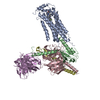
|
|---|---|
| 1 |
|
- Components
Components
-Guanine nucleotide-binding protein ... , 3 types, 3 molecules BCD
| #2: Protein | Mass: 40445.059 Da / Num. of mol.: 1 Source method: isolated from a genetically manipulated source Source: (gene. exp.)  Homo sapiens (human) / Gene: GNAI1 / Production host: Homo sapiens (human) / Gene: GNAI1 / Production host:  Insect BA phytoplasma (bacteria) / References: UniProt: P63096 Insect BA phytoplasma (bacteria) / References: UniProt: P63096 |
|---|---|
| #3: Protein | Mass: 37915.496 Da / Num. of mol.: 1 Source method: isolated from a genetically manipulated source Source: (gene. exp.)  Homo sapiens (human) / Gene: GNB1 / Production host: Homo sapiens (human) / Gene: GNB1 / Production host:  Insect BA phytoplasma (bacteria) / References: UniProt: P62873 Insect BA phytoplasma (bacteria) / References: UniProt: P62873 |
| #4: Protein | Mass: 7861.143 Da / Num. of mol.: 1 Source method: isolated from a genetically manipulated source Source: (gene. exp.)  Homo sapiens (human) / Gene: GNG2 / Production host: Homo sapiens (human) / Gene: GNG2 / Production host:  Insect BA phytoplasma (bacteria) / References: UniProt: P59768 Insect BA phytoplasma (bacteria) / References: UniProt: P59768 |
-Protein / Antibody / Non-polymers , 3 types, 3 molecules AE

| #1: Protein | Mass: 42898.754 Da / Num. of mol.: 1 Source method: isolated from a genetically manipulated source Source: (gene. exp.)  Homo sapiens (human) / Gene: S1PR1, CHEDG1, EDG1 / Production host: Homo sapiens (human) / Gene: S1PR1, CHEDG1, EDG1 / Production host:  Insect BA phytoplasma (bacteria) / References: UniProt: P21453 Insect BA phytoplasma (bacteria) / References: UniProt: P21453 |
|---|---|
| #5: Antibody | Mass: 26293.299 Da / Num. of mol.: 1 Source method: isolated from a genetically manipulated source Source: (gene. exp.)  Homo sapiens (human) / Production host: Homo sapiens (human) / Production host:  Insect BA phytoplasma (bacteria) Insect BA phytoplasma (bacteria) |
| #6: Chemical | ChemComp-J8C / |
-Details
| Has ligand of interest | N |
|---|---|
| Has protein modification | Y |
-Experimental details
-Experiment
| Experiment | Method: ELECTRON MICROSCOPY |
|---|---|
| EM experiment | Aggregation state: 3D ARRAY / 3D reconstruction method: single particle reconstruction |
- Sample preparation
Sample preparation
| Component | Name: S1PR1/Gi complex / Type: COMPLEX / Entity ID: #1-#5 / Source: RECOMBINANT |
|---|---|
| Source (natural) | Organism:  Homo sapiens (human) Homo sapiens (human) |
| Source (recombinant) | Organism:  Insect BA phytoplasma (bacteria) Insect BA phytoplasma (bacteria) |
| Buffer solution | pH: 7.5 |
| Specimen | Embedding applied: NO / Shadowing applied: NO / Staining applied: NO / Vitrification applied: YES |
| Vitrification | Cryogen name: ETHANE |
- Electron microscopy imaging
Electron microscopy imaging
| Experimental equipment |  Model: Titan Krios / Image courtesy: FEI Company |
|---|---|
| Microscopy | Model: FEI TITAN KRIOS |
| Electron gun | Electron source:  FIELD EMISSION GUN / Accelerating voltage: 300 kV / Illumination mode: OTHER FIELD EMISSION GUN / Accelerating voltage: 300 kV / Illumination mode: OTHER |
| Electron lens | Mode: BRIGHT FIELD |
| Image recording | Electron dose: 60 e/Å2 / Film or detector model: GATAN K2 SUMMIT (4k x 4k) |
| EM diffraction | Camera length: 800 mm |
| EM diffraction shell | Resolution: 3→5.5 Å / Fourier space coverage: 93.2 % / Multiplicity: 2.5 / Num. of structure factors: 244 / Phase residual: 13.5 ° |
| EM diffraction stats | Fourier space coverage: 90.3 % / High resolution: 2.83 Å / Num. of intensities measured: 1590 / Num. of structure factors: 325 / Phase error rejection criteria: 20 / Rmerge: 0.198 |
- Processing
Processing
| EM software |
| |||||||||
|---|---|---|---|---|---|---|---|---|---|---|
| CTF correction | Type: NONE | |||||||||
| 3D reconstruction | Resolution: 2.86 Å / Resolution method: FSC 0.143 CUT-OFF / Num. of particles: 500000 / Symmetry type: POINT | |||||||||
| Atomic model building | Protocol: OTHER / Space: REAL | |||||||||
| Atomic model building | PDB-ID: 6VMS Pdb chain-ID: A / Accession code: 6VMS / Source name: PDB / Type: experimental model |
 Movie
Movie Controller
Controller




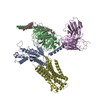
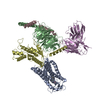
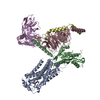


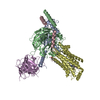


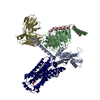

 PDBj
PDBj































